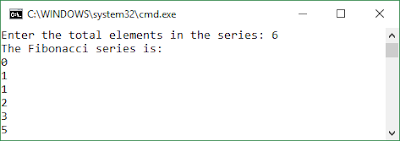In mathematics, the Fibonacci numbers or Fibonacci sequence are the numbers in the following integer sequence:
01, 1, 2, 3, 5, 8, 13, 21, 34, 55, 89, 144.....
The Fibonacci spiral: an approximation of the golden spiral created by drawing circular arcs connecting the opposite corners of squares in the Fibonacci tiling; this one uses squares of sizes 1, 1, 2, 3, 5, 8, 13, 21, and 34.
By definition, the first two numbers in the Fibonacci sequence are either 1 and 1, or 0 and 1, depending on the chosen starting point of the sequence, and each subsequent number is the sum of the previous two.
Information source: wikipedia.org
Program:->
 |
| Output |
#include <iostream>
using namespace std;
int fibo(int);
int main() {
int n,i;
cout<<"Enter the total elements in the series: ";
cin>>n;
cout<<"The Fibonacci series is: \n";
fibo(n);
return(0);
}
int fibo(int x) {
int f=-1,s=1,n;
for (int i = 0; i < x; ++i) {
n=f+s;
f=s;
s=n;
cout<<n<<"\n";
}
return(0);
}













Fibonacci string in c selection: c program for Fibonacci series without with recursion. Using the code below you possibly can print as many amounts of terms of string as desired. Amounts of Fibonacci sequence are often known as Fibonacci numbers. First few amounts of series are 0, 1, 1, 3, 3, 5, 8 etc, Except first two terms in sequence another term is the sum of the two previous phrases, For example 8 = 3 + 5. This sequence has many applications in math concepts and Computer Science.
ReplyDeleteContact here